New research reveals an increase in stress, tiredness and anxiety among business drivers during winter months, bringing risk management implications for companies.

Analysis of more than 3,000 business drivers using RED Driver Risk Management’s Wellbeing Profiler has shown that a fifth of drivers (20%) claim to feel tired during the winter months, and for some the issue is worse still, with 12% claiming to be ‘exhausted’.
A total of 10% say they experience anxiety during the darker days too.
RED has dubbed the condition ‘Seasonally Affective Driver Disorder’ (SADD) and warned that it affects all types of business drivers, from company car to delivery van and HGV, and could bring higher risks, exacerbating the chances of crashes, along with lower productivity.
The Wellbeing Profiler tool – which checks drivers monthly, offers instant feedback and advice and provides corporate reports – also explored employee attitudes and engagement in winter, and found there is a significant shift in this area as well: an 8% drop in the number of employees feeling motivated, while the percentage of drivers feeling ‘very discouraged’ doubles and ‘enthusiasm’ wanes by nearly 10%.
RED Driver Training CEO Ian McIntosh said: “We ask 79 different questions that look at areas such as tiredness, anxiety, employee engagement, mental clarity, decisiveness, self-esteem and lifestyle, and in every single metric, there is clear evidence that drivers struggle more in winter than other seasons.
“Anybody who drives a lot knows that it can be especially tough during the winter. From the moment you get out of bed in the dark and have to scrape the ice off in the cold, we know that business motoring in the winter months is hard work.
“But this is the first time we have been able to definitively get a picture of the scale of it, through analysis of our Wellbeing data. It showed that around one in 10 business drivers suffer from some form of SADD-related issue during the winter months. That is a lot of employees who are struggling and need help.”
The firm also points to data from RoSPA, which shows that collision rates increase by 19% in the fortnight after the clocks are turned back, and other winter-based emotional health factors. According to the NHS, the exact cause of SAD (seasonal affective disorder) is not fully understood, but it is thought that a lack of sunlight might stop a part of the brain called the hypothalamus working properly, which may affect the production of melatonin, making you feel sleepy. Also, lower serotonin levels can affect mood, appetite and sleep, and shift the body’s internal clock out of kilter.
RED Driver Training has warned that drivers affected could be at more risk of having an accident and that there are a number of ways that employers can take action.
McIntosh continued: “For employees who really struggle with this, employers could do a number of things. They could try and reduce their mileage by doing more video-conferencing, or reschedule appointments so employees are not doing long drives in the morning or evening when the risks are higher.”

